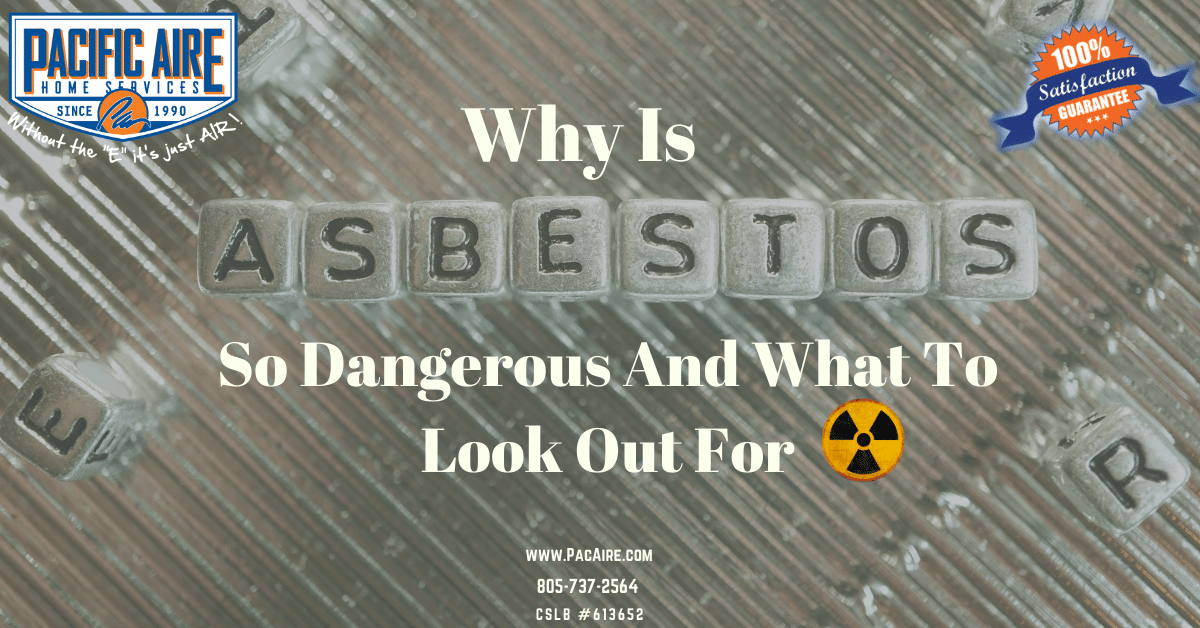Learn what asbestos is and when scheduling an asbestos removal is necessary.
There is a good chance that your attic contains asbestos insulation if your home was built in the 1980s or earlier. In the past, asbestos was commonly used to insulate homes with heat. Now that it is widely recognized as dangerous, most modern homes use alternative materials. Consider having asbestos removed from your home to protect your health and the air quality in your home.
What is Asbestos?
Asbestos is a natural mineral made of microscopic fibers. The fibers are usually white and so thin that they are practically invisible. During the 1970s, asbestos was used to insulate pipes, ducts, ceiling acoustics, mastics, and laminate flooring in many homes.
Since asbestos is such an excellent insulator, it is typically found in homes equipped only with a heating system. It’s usually found in attic and wall insulation. It was first discovered as a danger when asbestos was combined with air conditioning.
When asbestos-containing materials are disturbed during the use of products, demolition, home maintenance, repair, and remodeling work, asbestos fibers are released into the air. Asbestos exposure occurs only when asbestos-containing material is disturbed or damaged. That’s when the particles become airborne.
Why Is Asbestos So Dangerous?
If the air ducts had asbestos insulation, air conditioning would cause the ducts to condense. When asbestos is exposed to water, it will absorb it, break down, rust and corrode. This will consequently allow a large amount of fiber to freely enter the air supply.
The fibers in asbestos pose a threat due to their size. Their size and shape is quite tiny, and they also split in different directions. The fibers embed themselves into the lung tissue when inhaled. Damage to asbestos can make its fibers airborne and pose a risk to anyone who breathes the toxic dust.
Asbestos Related Diseases:
- Lung cancer
- Mesothelioma is a type of cancer that develops in the lungs, abdomen, and heart as a result of an asbestos fiber exposure.
- Asbestosis could develop with prolonged Asbestos exposure
How to Identify Asbestos In Your Home
Most materials do not contain asbestos unless they are marked. If they aren’t, it can be determined by examining them. Assume that the material contains asbestos. Leave it alone if in doubt. Hire a professional to inspect your home for asbestos-containing materials if:
- You want to renovate your house as you may disturb building materials
- There is damage to the building materials, such as crumbling drywall and insulation.
Asbestos removal should be performed by a trained and accredited professional. Trained workers know how to look for asbestos fibers, and because fibers are released in the air, they may pose a health risk. The sample can actually be more hazardous if taken incorrectly than if it was left alone.
Encapsulation and/or Removal of Asbestos
It is only possible to eliminate asbestos through abatement. By removing asbestos, indoor air will be free from asbestos fibers.
Asbestos removal is a unique and particularly challenging project that shouldn’t be undertaken by the homeowner. To avoid exposure to asbestos, it is best to use a certified asbestos abatement contractor rather than doing-it-yourself. Pacific Aire is certified to remove asbestos. During preparation, our technicians set up containment areas. Protective gear such as gloves and goggles are worn during the removal process, and an air filtration system is used to purify the air.
It is important for us to carry out a thorough removal. In some cases, asbestos ductwork is only removed and the vent boot is left behind when done by other contractors. As a result, asbestos remains in your home.
During asbestos removal, asbestos-containing materials are soaked. It is important to wet all asbestos waste before it is double bagged and enclosed in a plastic bag. The container should be leak-proof and labeled. There are special landfills designated for asbestos waste that must be used for its disposal.
Pacific Aire Offers Professional HVAC Services
Our technicians are trained to handle asbestos problems. Our team does an excellent job of removing asbestos to make sure that none of it is left behind.
All ducts and vent boots are stripped down. Asbestos is removed and collected from the affected areas. Using a special coating, the area is then sealed so that whatever cannot be removed or seen from one location is captured in one place.
With Pacific Aire, you can rely on quality asbestos abatement. Your home will be in good hands with our technical knowledge and friendly customer service. For more information about asbestos removal, please contact our helpful representatives.
Visit https://bit.ly/PacAire_tune_up or call us at 805-737-2564 to schedule your AC tune up today.


